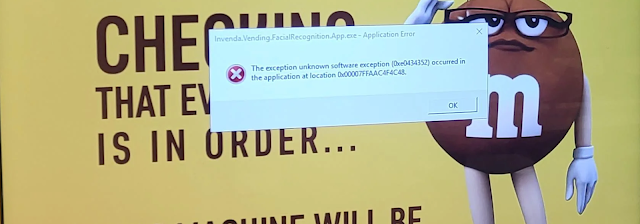
In the seemingly innocuous corners of our daily lives, where the simple act of purchasing a snack can evoke a sense of joy, a complex narrative unfolds—one that interweaves the vibrant allure of M&M's candy vending machines with the sobering realities of modern surveillance and data privacy concerns. This narrative transcends the mere act of transaction to pose profound questions about the intersection of technology, privacy, and the unsuspecting consumer, echoing larger, more disconcerting trends in data collection practices that have emerged in recent years.
On a seemingly uneventful evening, the digital community was stirred by an image posted by a Reddit user known as 'SquidKid47' on the r/uwaterloo subreddit. The image displayed an error message from a canary yellow M&M's vending machine, revealing an application named "Invenda.Vending.FacialRecognitionApp.exe" had encountered an issue. This inadvertent revelation peeled back the layers of a sophisticated system designed to observe, analyze, and potentially infer characteristics about the individuals it encounters, all under the guise of a routine snack purchase.
The thread of inquiry leads us to Adaria Vending Services, the operational face behind these machines, and further upstream to their creator, Invenda Group. Invenda stands out in the landscape of vending solutions with its intelligent machines that promise more than the mere dispensing of products. These machines are embedded with capabilities that extend into the collection of sales data and user interactions, and more invasively, the harvesting of demographic information such as estimated ages and genders of those who stand before them.
This situation mirrors a controversy that previously ensnared Cadillac Fairview, a titan in the Canadian real estate market known for its ownership of landmark shopping malls. A CBC investigation brought to light the company's employment of facial recognition technology within mall informational kiosks to compile data on millions of unknowing patrons. The parallel narratives underscore a growing trend where biometric data, collected without consent, is utilized for purposes that extend beyond the surface-level convenience of technology, veering into the realm of privacy erosion.
In discussions of personal data usage, the principle of consent cannot be overstated. Technologies like Apple's Face ID, which have woven themselves into the fabric of our daily routines, operate on the bedrock of user consent, offering a model of convenience balanced with security. However, the use of biometric data by Invenda's M&M machines, akin to the practices of Cadillac Fairview, navigates a gray area of privacy, raising pivotal questions about the ethics and implications of such data collection without explicit consent.
Adaria Vending Services, faced with these concerns, asserts their adherence to privacy norms and regulations such as the GDPR, arguing that their technology merely detects motion to activate the vending interface without capturing or storing identifiable information. However, this stance does not fully address the potential for demographic data collection and its subsequent sharing with entities like Mars, the manufacturer of M&M's, or other third parties.
In a counterargument, Invenda's leadership insists that their technology is designed to function in a non-invasive, local manner, processing digital image maps in real-time without the retention or transmission of personal data, thereby challenging the portrayal of their vending machines as privacy-intrusive devices.
This unfolding story of the M&M's vending machines at the University of Waterloo, prompted by the observant eye of 'SquidKid47' and further investigated by River Stanley of MathNews, encapsulates the broader dilemmas and debates that our increasingly digital society faces. It compels us to critically assess the boundaries of surveillance, the ethics of data collection, and the transparency required from those who navigate these complex waters. As technology persistently blurs the lines between convenience and privacy, it is incumbent upon consumers, regulators, and corporations to proceed with vigilance and integrity, ensuring that the rights and expectations of privacy are not only respected but also protected.





0 Comments